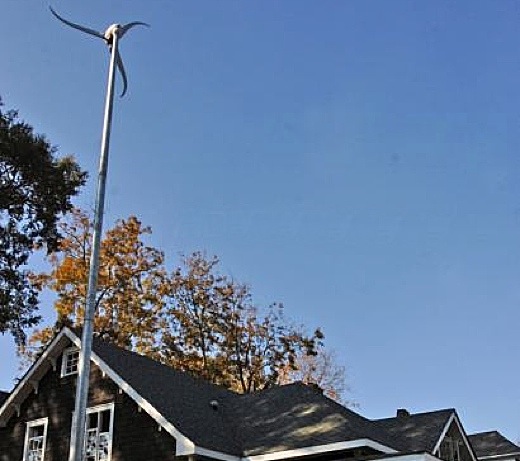SUBHEAD: Kauai residents should have the right to install a windmill to help power their homes and businesses.


Image above: A residential windmill generator installation.
From http://windenergy7.com/turbines/?tag=small-wind
By Staff on 2 August 2009 in The Garden Island News -
http://www.kauaiworld.com/articles/2009/08/02/opinion/kauai/doc4a7512d36b003166710963.txt
To say the time to move on alternative energy sources is now is a gross understatement. That time has long since come and gone.
Every day we don’t move into the future to lessen our dependence on foreign oil is a day that is wasted. So when our county government has a chance to help us develop our own energy technologies, it has to jump at that chance.
The Kaua‘i County Council is debating whether to start work in earnest on a bill that would promote the effective and efficient use of small wind energy conversion systems, or SWECS, by creating a legal framework for property owners to mount them on towers and roofs.
The apparent alternative is to wait for six months, or perhaps longer, for the comprehensive island-wide energy sustainability plan to tell us what renewable energy technologies we should be pushing and which we should choose to ignore. Council Vice Chair Jay Furfaro has said repeatedly that he wants to get what we paid $200,000 for — an expert opinion telling us which way to move. The only problem with that is the consultants working on the plan have told the council that SWECS fit in perfectly with what the plan will say when the final version comes out (slated for January 2010).
Doug Hinrichs of Sentech wrote in an e-mail to Councilman Tim Bynum that “any legislation that promotes clean energy — such as the SWECS does — certainly dovetails with the Kaua‘i Energy Sustainability Plan, in my humble opinion.”
Sub-contractor Maurice Kaya told Bynum in an e-mail that “Proceeding with such a policy is expected to be consistent with the intent of the Kaua‘i Energy Sustainability Plan.
“... Wind energy, just like solar thermal and solar photovoltaic systems, can be encouraged at the customer level as prudent public policy,” Kaya wrote.
We may get some more clarity on what the plan will say soon. Economic Development Director George Costa told the council a draft outline would be made available by the end of July and Hinrichs and/or Kaya could be in Council Chambers in a couple of weeks to explain what’s coming down the pike.
Furfaro said he thinks the plan will outline specific legislative options for the council to properly encourage various renewable technologies, and he doesn’t want to jump the gun. Even if he’s right, passing this law now doesn’t preclude the council from taking further legislative actions later; it could even repeal this law in the unlikely event it turns out to contradict our greater plans. If the council wants to play it extra safe, it could include a six-month or one-year sunset clause that would ensure that it needs to be re-evaluated when the overriding sustainability plan comes out.
But even if the report pushes for solar photovoltaic, large-scale wind farms or nuclear power in lieu of small-scale home windmills, it’s wrong for government to force consumers to wait for businesses to pick up the ball on those major projects by limiting our personal options to go green.
SWECS will allow some of us to lessen our dependence on imported oil by harnessing a natural resource. We can already put solar panels on our roofs and there is already an incentive to purchase solar-powered water heaters. We can already go to the Planning Commission and get permits for SWECS; an estimated half-dozen Kaua‘i residents have already done so.
This bill would create a clear legal process for interested parties to follow and hopefully remove the run-around game people currently have to play with various county agencies. Building permits will still be required. Health code restrictions will still be applied. It’s not going to be as simple as driving to The Home Depot and slapping a windmill on your roof. This will still be properly regulated.
But the improved efficiency of the process will open the door for more people to get on the bandwagon. The interest is there. As of Friday evening, 75 percent (132 of 175) of those surveyed in a non-scientific poll on The Garden Island Web site responded in the affirmative when asked “If the county approves a law to regulate windmills, would you put one up on your property?”
As for the concerns some community members have raised over noise nuisance and visual blight: We say those are small prices to pay for energy independence. Nobody wants to hear the whirring of a windmill at 3 a.m. (although the latest technology has reduced the sound to less than that of a window air-conditioning unit), and nobody wants their view of the majestic mountains blocked by their neighbor’s new system. But we shouldn’t ignore the less apparent price we pay for our existing oil-based energy consumption.
The economic and environmental costs of boating in our fuel go way past the point of being a nuisance; they pose a mortal threat to our way of life on this island and on this planet.
It’s time to move forward on new energy technologies. Doing so responsibly is reasonable, but hiding behind the study is not. The County Council’s Planning Committee should start its work on the bill when it returns to the agenda Aug. 12, and it should work hard to pass the bill as quickly as possible.
In our opinion, residents should have the right to install a windmill to help power their homes and businesses. The county should not delay passing the legislation necessary to enable this to happen efficiently and safely on Kaua‘i.
No comments :
Post a Comment